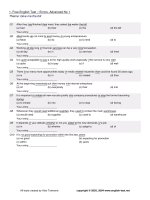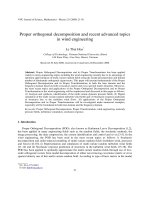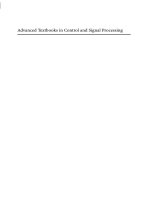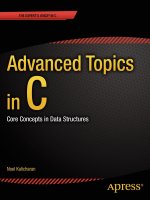swayne advanced degree in holdem
Bạn đang xem bản rút gọn của tài liệu. Xem và tải ngay bản đầy đủ của tài liệu tại đây (6.21 MB, 435 trang )
Foreword by
Daniel Negreanu
Swayne’s
ADVANCED DEGREE
in
Hold’em
CHARLEY
SWAYNE
CHARLEY
SWAYNE
Swayne’s ADVANCED DEGREE in Hold’em
ECW
Copyright © Charley Swayne, 2009,
as President of Advanced Degree Poker, LLC
Published by ECW Press, 2120 Queen Street East, Suite 200,
Toronto, Ontario, Canada M4E 1E2
416.694.3348 /
All rights reserved. No part of this publication may be reproduced,
stored in a retrieval system, or transmitted in any form by any process
— electronic, mechanical, photocopying, recording, or otherwise —
without the prior written permission of the copyright owners and
ECW Press.
Library and Archives Canada Cataloguing in Publication
Swayne, Charles B
Swayne’s advanced degree in hold ’em / Charley Swayne.
ISBN-13: 978-1-55022-866-3
ISBN-10: 1-55022-866-6
1. Poker. I. Title. II. Title: Advanced degree in hold ’em.
GV1251.S93 2009 795.412 C2008-907550-1
Cover and Text Design: Tania Craan
Typesetting: Florence Aliesch
Printing: Transcontinental
1 2 3 4 5
Printed and Bound in Canada
Carol has never seen one hand of poker, not even on television.
When I proudly showed her my WSOP Academy instructor
website she asked, “What’s a wooosop?”
No man has ever had a more wonderful wife than Carol, or better
sons than Joe, Brian, and Chuck.
CONTENTS
Foreword by Daniel Negreanu
vii
1
Introduction
1
2
The Swayne PATL Matrix
13
3
Reading Opponents and Their Hands
Part I – General hand strength
Part II – Physical changes
Part III – Postflop hands
26
4
Deception
44
5
Boardology
49
6
Playing the Blinds
61
Test 1
66
7
The Numbers Chapter
Part I – Probability and hand frequency
Part II – The Swayne hand pyramid
Part III – Odds, probability, pot odds, and Expected Value
Part IV – Preflop
72
8
Relative Strength
106
Test 2
120
27
31
36
72
74
77
88
Which Hands to Play
Part I – The Advanced PATL Matrix
Part II – Win Factors
Part III – Win Factor adjustments for position
Part IV – Win Factor adjustments for passive/aggressive
Part V – Hands you may consider playing
Part VI – Horse adjustments
Part VII – Pot size
131
Test 3
228
10
Betting
238
11
No Limit
274
Final Exam
344
12
Ultimate Texas Hold’em
351
13
Preface/Postface/Conclusion
364
Bibliography
Acknowledgments
Author/Seminars
379
9
Appendices
Appendix A – Endnotes
Appendix B – Boardology
Appendix C – Winning Probabilities
for Specific Hands and Flops
Appendix D – Hobby, Profession or More!
Appendix E – Test and Final Exam Answers
Glossary
133
138
183
187
197
212
216
381
382
383
394
395
411
413
415
Foreword
You know they say that poker is a game that takes five minutes
to learn but a lifetime to master. It may take a little more than
five minutes to learn, but it does indeed take a lifetime to master.
When I first started playing Hold’em, books and training devices
were few and far between. We are straight up spoiled today! There
is an abundance of poker training tools out there that claim to
make you a better all-round player; however only a few give you
a serious return on your investment.
As you may know, I’m constantly trying to learn more about
the game and add more weapons to my poker arsenal. Most of
the stuff I read is commonplace and a dime-a-dozen. However,
Swayne’s Advanced Degree in Hold’em really grabbed my attention through
several cutting edge concepts. The PATL (Passive Aggressive Tight
Loose) and Advanced PATL matrices, Swayne’s Win Factors and
Relative Strength Evaluations (just to name a few) are a direct
result of Charley’s extensive academic background and thorough
understanding of the game. Charley’s innovative concepts not
only will give you the opportunity to become a great poker
player, they will allow you to play with unmatched confidence.
I was so impressed with his school of thought that I asked him
to join my Poker VT team at the very start. It turned out to be
Foreword
vii
quite the good decision. Not only does Charley have an in-depth,
easy-to-use mathematical strategy, he and I developed the everso-challenging N-SPAT (The Negreanu-Swayne Poker Aptitude
Test) seen on Poker VT.
So why would I back Charley’s book? The answer is quite
simple. Swayne’s Advanced Degree is like nothing I have ever seen
before and offers readers of all experience levels, even the weak
little fish, the tools necessary to become a better Hold’em player.
Contrary to what you may believe, I’m all for feeding the fish
knowledge. After all, it’s better for the competitive nature of the
game I love.
Daniel Negreanu
April 2009
viii
Swayne’s Advanced Degree in Hold’em
CHAPTER 1
Introduction
Just what you wanted to see when you opened the book. A
disclaimer. Of course I am covering my tail. Neither Advanced
Degree Poker, LLC, I, my sons, nor this book guarantees you
anything. I do not guarantee you will win. Everything in this book
is for your information only. This book may not be construed as
offering you any type of advice with regard to poker gambling.
It is your responsibility to evaluate the information presented in
this book. It is also your responsibility to follow the laws that
apply in your state or country with regard to playing poker. If you
are unsure about the status of playing poker consult your own
attorney. I, the publisher, and anyone else involved with this book
do not endorse or guarantee anything presented in this book. You
assume all responsibility for your actions. If you do not agree
to any of these conditions, immediately return this book from
the place you purchased it for a full refund. If that place does
not give you a full refund, immediately write directly to me,
Charley Swayne. Give me the name, address, and phone number
of the retailer who refused to give you a full refund. Include
the book and receipt, and I will send you a full refund of your
purchase price. The address is Advanced Degree Poker, LLC, N.
1964 Crestview Place, La Crosse, WI 54601, USA.
Introduction
1
How important is poker?
The first day of poker class. The professor wheeled a cart into a
packed room. On the cart were a very large glass jar and four
boxes. He silently filled the jar with golf balls from one of the
boxes. He asked the students if the jar was full. “Yes,” was the
response.
He then opened another box which contained pebbles. He
poured the pebbles into the jar with the golf balls, making sure
to shake the jar so some pebbles made their way to the bottom.
“Now is the jar full?” The class agreed it was.
Another box with sand. The sand went into the jar. He again
asked the class if the jar was full. A very loud, “Yes!” was heard.
Then out of the last box he pulled out a can of beer. He then
proceeded to fill the jar to the brim.
As the laughter quieted down, the professor said, “The golf
balls are the truly important things in your life.Your family, honor,
health, service to others, and for some of you God. The pebbles are
important but if you lost the pebbles you could start over. Pebbles
are your wealth, job, fame, friends, money, and possessions. The
sand is the fun things in your life, stuff you could do without but
you enjoy doing. Hobbies, pastimes, relaxing.”
“What would happen if we put the sand in the jar first? You
couldn’t get the golf balls or pebbles in. If you filled your jar with
sand first, there would be no room for your family, your health.”
A long pause. “Poker is sand. For some, poker is pebbles. But,
poker should never become golf balls.”
The students were silent for a few seconds. Finally, one asked
what the beer represents. The answer: “No matter how much you
have, there is always room for a beer.”
Now the real introduction
Welcome. This intro is brief. All of the usual things you find at the
start of a book are at the end of this one because if you are like
me, you want to get to the meat of something fast.
The more you know, the less you fear. I will show you how
to know more than most of your opponents. It is assumed you
know how to play. If you are a beginner there are several books in
Appendix A which will give you all the basics.
2
Swayne’s Advanced Degree in Hold’em
Knowledge and skill
Certain skills and specific kinds of knowledge are necessary to be
a great hold’em player — similar to the wheels of a bicycle. You
need the back wheel to guide your decisions. You need the front
wheel for your actual decision making.
The knowledge is math. This is your back wheel. Without
knowing the math, decisions are based on a hunch. Knowing the
math guides you into profitable decisions. Then there is a broad
range of strategies, tactics and skills which include having the guts
to bet hard, bluffing, semi-bluffing, check-raising, reading your
opponents and their hands. These skills are your front wheel. You
use these to decide how to play the hand. For shorthand I will
lump all of these poker strategies, tactics, and skills under the term
psychology, psych. You need to be both Spock and Kirk. Figure
1.1 shows the relative importance of math knowledge versus
psych skills depending on the type of hold’em game played.
Psych
Math
Psych
Psych
Low limit
Math
Math
High limit
No limit
Relative importance of math knowledge and psych skills depending on type of hold’em played
Figure 1.1
Is this book for you?
This book will more than satisfy limit players who need a superior
blend of psych skills and math knowledge and who expect to
win a minimum of 1.5 big bets per hour. Unless you are playing
others who know what you will learn, it is possible TO MAKE
A LIVING PLAYING HOLD’EM, even playing low limit. For
example, if you simultaneously play four $3/$6 tables on the
Introduction
3
net, you should expect to win $9 per table per hour or $36 per
hour. If you play low limit, $10/$20 or less, your primary focus
should be the math. If you play high limit, $30/$60 and up, your
emphasis needs to be on the psych skills. If you want to be a great
limit player you need both and this book is definitely for you.
If you want to focus on no limit tournaments, it is a long
road to becoming good. If you play no limit, you make the most
money by playing the people rather than the cards. And here’s
what I mean by a long road. Before you can become a good no
limit player you must become a great player at limit. And before
you become a good no limit tournament player, you must become
good at no limit cash play.
From this moment until the No Limit Chapter, we speak and
focus primarily on limit. The No Limit Chapter, Chapter 11, will
build on your limit expertise and then show you what it takes to
become good at no limit cash. Then, and only then, will you be
ready to learn the tortoise small ball play to get through major no
limit tournaments.
This is a book only for one who is very serious about his
game, not the casual player, not the player primarily out for fun,
although there is a section for beginners in Chapter 9 which shows
those starting out an oversimplified method for play. Although
written in a conversational tone, this is more like a college text,
than the traditional poker book.
The beginner, unless he is serious about the game, and
certainly the casual player, will find the concepts too complicated
and cumbersome to understand and apply.
Importance of skills during each round of betting
During your first round of limit your knowledge of math is most
important and becomes less important as betting continues.
Notice how much more important your psych skills are on the
flop and turn. No limit requires a greater emphasis of psych skills
on the flop as that’s where most of the moves are made.
4
Swayne’s Advanced Degree in Hold’em
Math
Psych
Psych
Preflop
Math
Psych
Psych
Math
Flop
Math
Turn
River
Importance of math knowledge and psych skills during each round of limit betting
Figure 1.2
Degree of difficulty
Figure 1.3.a illustrates the degree of difficulty of each betting
round in low limit. If you haven’t played much when you first
read Chapter 9 you will probably disagree but preflop play is
relatively easy. Eventually you will understand how easy preflop
play is compared to the flop and turn.
Preflop
Flop
Turn
River
Degree of difficulty during each round of low limit betting
Figure 1.3.a
Notice in figure 1.3.b the turn is the most difficult street
with high limit and no limit, as those games require many more
difficult decisions on the turn, especially in no limit.
Introduction
5
Preflop
Flop
Turn
River
Degree of difficulty during each round of high limit and no limit betting
Figure 1.3.b
Postflop play
From the above figure it is obvious postflop play is the most
important part of a hand. We will take a lot of time developing
starting hands and the flop, insuring you are an expert for these
two betting rounds, before you are introduced to extensive
postflop play. You will find most of your opponents have only
poor to good postflop skills. Your ability to play as an expert
postflop will separate you from the vast majority of opponents.
Book outline
Here’s the general outline of the book:
First, psych skills are emphasized.
• You will be introduced to a basic model of passive/
aggressive and tight/loose, and learn how to use that
model to develop your psych skills.
• A definitive chapter on reading opponents and hands.
• A chapter on a foolproof way to deceive every opponent.
Then we start to move into areas which are math based.
• How to study the board.
• Playing the blinds.
• A chapter with lots of numbers.
• The relative strength of hands depending on how many
opponents you have.
• An advanced mathematical model of passive/aggressive
and tight/loose.
6
Swayne’s Advanced Degree in Hold’em
• The seven determining factors for every limit hand. They
are:
• How loose or tight the table is.
• How passive or aggressive the table is.
• Your card strength.
• Number of opponents.
• Position.
• The horse.
• Pot size.
• An extensive and exhaustive analysis of all seven factors.
Toward the end there is a blending of math knowledge and
psych skills with the Betting Chapter. After that, we move
into no limit where we will have to add an additional three
determining factors to the seven above:
• The type of no limit game.
• Stack size.
• Unlimited betting.
Then we examine how to play no limit tournaments. Last,
there is a special math based chapter on the casino game,
Ultimate Texas Hold’em.
Even though most of the introduction is in the very back, more of
a postface than a preface, there are a few important topics which
need to be covered.
Experience
Education only goes so far. Experience is the comb nature gives us
when we are bald. Experience is the name we give our mistakes.
You need to be a balding mistake maker. With experience you
will develop the patience and discipline needed to only play and
stay in hands where you have a positive Expected Value.
How do you get experience? Play, play, play. You should play a
minimum of 250,000 hands before you consider yourself
experienced. All of these hands should be played using computer
practice, micro limit, or low limit tables.
Do not play for real money until you are experienced.
Real money is money you care about.
Introduction
7
Pre-computer players would play 30–35 hands an hour at a
casino or at a home game. In a five-hour night, with no toilet
breaks, they could get 150–200 hands played. Over a year they
might play a total of 8,000. It would take them 30 years to play
250,000 hands. Sure, some played three times as much and got
their experience in only a decade. Those are the ones whose
spouses divorced them, so they had the time to play more.
But you have computer software available; both Poker Academy
Pro and Wilson Turbo are excellent; they allow you to play several
thousand hands a week. You can play several tables on the internet
at once. Use a big screen and you can get four tables on one
computer screen or you can stack several tables on one screen.
Play four speed tables and you can play over 200 hands an hour,
well over a 1,000 a day. After a few months you can add another
monitor and play eight tables at once. Do the math. It just depends
on how much time you want to put in to become experienced.
Two years? One? It is up to you. Then, and only then, should you
play for real money.
Why play so many hands? So that you gather the full range
of experiences. You’ll receive pocket Aces over 1,100 times. You
will see some players defy all reason and draw all the way to the
river and beat you. But the most important things you will learn
are the patience and emotional stability to wait for the right cards
and the discipline to make the right decisions on how to play or
fold your hand.
Some experts learn superior postflop skills from coaching,
seminars, books and experience. Others from experience alone.
But the ability to get away from a marginal hand and read an
opponent must include experience.
Simple but not easy
Every effort has been made to simplify an extremely complex
subject. Some steps have been left in so expert players can
follow the logic to see if they agree. Many of the laborious and
mathematical formulas, statistical details, and several thousands
of pages of data have been omitted. Even though we believe the
material is presented in the easiest-to-understand manner, you
need to know mastering all of the concepts will not be easy. The
only place success comes before work is in the dictionary.
8
Swayne’s Advanced Degree in Hold’em
Good or world class
One of the benefits of teaching is helping a student with his/her
life’s plan. I don’t know the answers, but I do know the questions.
We spend several hours finding out what they are good at and
love to do. Where their “good at’s” and “love to’s” converge is
their natural strength; why they were put on this earth. Once we
discover this intersection, it is surprisingly easy to then choose
how they should spend the rest of their life. Many ask about their
weaknesses. My advice is always the same. Spend most of your
time building on your strengths; do not focus on compensating
for weaknesses. This approach works well throughout life as
we can always find others or other ways to compensate for our
weaknesses.
Why bring this up? Because it doesn’t work with poker. You
are in a one-person business. No one but you can make up for
a weakness. You can choose to be a good player or a world class
player. This book will, at a minimum, make you a good player. If
good is your objective you will learn those things that are part of
your natural strengths and look over and perhaps become familiar
with those details that don’t excite you.
If you choose to be a great player you must learn and do
everything. Becoming great demands doing and learning some
things which are not fun. Accept the fact you cannot overcome a
weakness naturally; it does take extra practice. The true difference
between ordinary and extraordinary is extra. Compensating for
weaknesses may not be enjoyable but becomes bearable if you
look at it through the lens of a march toward being the best.
You cannot fail to know which hands you can play and when.
You must be patient and wait for the right hands. You must be
selectively aggressive. You can’t skip the 10,000 practice readings
of the board (yes, that’s one assignment). You must know the
minimum bets needed in the pot before you can even consider
drawing to an inside straight. You must keep a complete and
thorough log. It goes on and on. No matter what your personality
you are going to find things in this book you don’t like or want to
do. But every step will increase your competitive advantage. The
choice is yours. Good or world class. Commercial: If you go to
PokerVT.com, Mr. Daniel Negreanu and I willl personally teach you
to be world class.
Introduction
9
Low
Lim
it
Making a living by being a good player
Is it possible to make a living playing hold’em by being good? Yes,
but it is a grind if you are only winning 1 big bet per hour. There
are too many good players. Good players are everywhere. Good
is not nearly good enough. If you really want to make a living
working this game, you must become world class. You must be
able to consistently, over a long period of time, make at least 1.5
big bets per hour in limit. How about no limit? Carefully study
figure 1.4.a. No limit, especially no limit tournaments, cannot be
thoroughly mastered until you work your way up the pyramid.
The foundation is low limit. Figure
1.4.b reinforces the concept to play
¼ million hands of low limit before
you start playing for money you care
about.
Limit is so important that over
80% of this book is dedicated to you
becoming a great low and high limit
player. The least expensive, but best
way to become good at no limit, is to
first become world class at limit. If you
don’t there will be holes in your game
and the best players will exploit those
holes.
Once you are consistently making
1.5 big bets per hour in high limit,
you are ready to start no limit. You will
apply the same concepts learned in
limit to no limit cash games. You will
Figure 1.4.a
then move into no limit tournaments
where the blinds go up fast. Here
you will find a different style of play
is required. Then, and only then, are
Must First
you ready to play professional no limit
Play
250,000 Hands
tournaments. Tournaments where the
blinds go up slowly and everyone starts
off with deep stacks. At this level, you
er
d low
20 an
$10/$
must be proficient in every possible
style of play. And we’ll show you how.
This is a long road, but it leads to
success.
Figure 1.4.b
10
Swayne’s Advanced Degree in Hold’em
Repetition
Some concepts, principles, or numbers are so important, but too
easily missed, that they are repeated often. And some things don’t
lend themselves to part of a logical progression so they appear
out of nowhere.
Errors
Some of the concepts and the bulk of the data in this book
are original. You will see the results of billions (no typo) of
calculations. And we have checked and rechecked everything. But,
when breaking fresh ground, with new ideas, new numbers, and
new charts, I certainly may have made a misnake or two, or more.
I’d like to say they were hidden in there to see if you could find
them, but that’s not true. If you find an error, or several, please
write me and let me know.
Gambling
What’s the difference between winning $1,000 and not losing
$1,000? The adrenaline rush of winning a $1,000 pot is the only
difference. Mathematically there is no difference. Chasing with a
bet here and a bet there (here a bet, there a bet, everywhere a bet,
bet) when the numbers are wrong is gambling and will end up
costing you much more than $1,000. If you know the numbers
you will know when to fold early and will not chase unless the
numbers are right. You must learn how to catch and release.
Luck is where preparation meets opportunity. Knowing the
numbers is the preparation. Using your psych skills and playing
the numbers, not the bookie kind, is a true limit hold’em
opportunity. You are going to create your own luck.
Playing the numbers in limit is not gambling. Gambling is
failing to use your psych skills and follow the numbers. Gambling
is getting bored and playing A9 — a hand you may only play
in very limited circumstances. That may cause you to think a
little. No limit does require you to gamble and guess now and
then. But, following the numbers will keep you out of hands
you are likely to lose and put you in hands you are likely to win.
Following the numbers will keep you from betting when you
have a low Expected Value draw and insure you bet when you
have a high Expected Value draw. When you are finished with this
book, whether you decide to devote yourself to limit or no limit,
your decisions will be based on a combination of numbers and
psych, not hope.
Introduction
11
Begin with the end in mind
When you complete your first reading, you will have been
exposed to hundreds of concepts and details. You are not done.
The end comes only when all of the tactical details mesh together
in your mind into a strategy which allows you to see the whole
at a glance. How do you get to this level? You will have to learn
one concept. Play and apply it. Then another concept. More play
and more application. Learn and do. Do and learn. If you keep at it
persistently, making a small improvement every day, you will not
feel a breakthrough, but eventually you will see everything. The
imprecise will have turned into the certain. When you get to that
point, you will play with a confidence your opponents can smell.
Summary
• Poker is not the most important thing in life.
• A blend of superior math knowledge and psych skills is needed
in hold’em.
• Postflop play separates the good from the great.
• Don’t play for real money until you are experienced.
• To make a living at this game, being good is not good enough.
You must become world class.
• Becoming world class requires work.
• The most efficient path to becoming an expert in no limit, is to
first become a world class limit player.
• The concepts in this book are simple, but not easy.
• It takes a long time to see everything at a glance.
Improvement with homework and tests
Homework is given. Most assignments do not include a suggested
amount of time or number of practices. You know when you are
familiar, then good, then competent, then expert. Some work
is nothing more than a brief review. Some will take months to
complete. Many students tend to fast forward through some
critical learning steps. To get the maximum benefit, you should
complete all the homework.
You will find three tests and a final exam. The answers are in
the back in Appendix E. If you miss anything, do not go forward
until you understand the correct answers.
Homework
• Play 250,000 low limit hands before you play for real money.
12
Swayne’s Advanced Degree in Hold’em
CHAPTER 2
Passive versus Aggressive
A passive player doesn’t raise much. An aggressive player raises
a lot. Figure 2.1.a illustrates the difference.
Aggressive
This page describes the model which will be used as the
foundation for the entire book.
Raise and re-raise
Passive
The Swayne PATL Matrix
Check and call
Figure 2.1.a
Tight versus Loose
A tight player plays few hands. A loose player plays lots of
hands. See figure 2.1.b.
Creating the matrix 2.1
Now we combine the concepts by using a matrix as a basic model.
A matrix is a box with other boxes in it. It is used to help make
decisions or understand information in a two-dimensional way.
The matrix we will use is called the PATL matrix. It is
pronounced “pat-tell” and rhymes with paddle; the P stands for
passive, the A for aggressive, the T for tight, and the L for loose.
At times the matrix will be used to describe an individual
player, as shown in figure 2.1.c. Other times it will describe an
entire table, as in 2.1.d. Before you continue, make sure you
completely understand both figures.
Plays
few
hands
Plays
lots of
hands
Tight
Loose
Figure 2.1.b
The swayne patl matrix
13
Passive
Aggressive
Plays few
hands but
raises when in
a hand
Plays a lot of
hands and
raises a lot
Plays few hands
Plays a lot of
and calls when
hands and calls
in
a lot
a hand
Tight
Loose
Individual PATL matrix
Aggressive
Few in a hand
but lots of
raising
Several players
in a hand and
lots of raising
Passive
Figure 2.1.c
Few in a hand
and little raising
Lots of players
in a hand and
little raising
Tight
Loose
Table PATL matrix
Aggressive
Great players
Passive
Figure 2.1.d
Good players
Poor players
Tight
Loose
The merry-go-round
As you go through the next few chapters it will feel as though you
are going around and around the PATL. You are. Why? Because
the later chapters build on earlier ones. Having a complete and
thorough understanding of the basic PATL will insure an easy
transition to a more advanced model.
Identifying players 2.2
Where they are
The worst players are loose. The best players are tight. You will
find a gaggle of poor players at loose tables.
Aggressive/tight games are played by the best players. If you
expect to be a winner at a tight table, you must be a good to great
player.
Poor players
Aggressive
Makes few
mistakes
Makes lots of
mistakes
Passive
Figure 2.2.a
Makes few
mistakes
Makes lots of
mistakes
Tight
Loose
Figure 2.2.b
14
The rest of this chapter gives you specific conditions you will
find, as well as overall tactics and strategies for you to use, in each
quadrant. A quadrant is a specific box within the PATL matrix.
Since each section is accompanied by a figure, this chapter has
numerical subdivisions, such as 2.1 above, which has figures
2.1.a-d included, 2.2 is the next section, which has figure 2.2.a-e
included, and so on.
Mistakes
Your brilliant play is not where you make your profit. Profit comes
from players who make poor decisions. The more mistakes, the
poorer the player. You want to play against loose players.
Alcohol is your ally, as long as you are not a user. When loose
players drink they make even more mistakes. Ein Prost. You don’t
have to be a great player at a loose table. You just have to be better
than most of those in the game.
Their names
Figure 2.2.c shows the names, at least the polite ones, more
experienced players use to describe others.
The noise tipoff
Most loose tables are loud, as opposed to the quiet-as-a-tree
tight tables.
Swayne’s Advanced Degree in Hold’em
Strategic and tactical decisions 2.4
Cost to benefit
The primary reason you want a passive/loose table is it gives
you your best return on your investment. This doesn’t mean
you win the biggest pots with a passive/loose game; it means
that when you do win, you win a lot compared to what you had
to invest in the pot.
Target size
You can bag a passive/loose player with a shotgun. An expert
sniper is needed for the aggressive/tight.
Aggressive
Maniac
Passive
Rock
Calling station
Tight
Loose
Aggressive
Quiet
Conversation,
laughter,
noisy
Passive
Figure 2.2.c
Quiet
Conversation,
laughter,
noisy
Tight
Loose
Aggressive
Chips
stacked
precisely and
tall
Chips
not neat
Passive
Figure 2.2.d
Chips
stacked neatly
Chips
not neat
Tight
Loose
Figure 2.2.e
Aggressive
Where to find players 2.3
Type of Hold’em
Passive/loose players tend to play low limit. You will find
passive/tights mostly at low limit tables, grinding away to win
their 1 big bet per hour. Aggressive/loose players don’t last long
at high limit. Aggressive/tights, the best players, focus on high
limit and no limit.
Special note. We will find in the no limit chapter there are
specific types of no limit tournaments where this matrix does
not hold.
Professional
High limit
No limit
Low limit
No limit
Passive
The chip clue
Another sign as to the flavor of the table is how the players’ chips
are stacked. Loose players tend to stack their chips poorly. The
messier the looser. Passive/tights have their chips stacked neatly,
in exactly the same heights, and sometimes in a creative pattern.
Some go so far as to align the marks on the sides of chips together.
This is a readable indication that this player is disciplined and will
patiently wait for the right hands to play. Aggressive/tights either
mirror the passive/tights or go one better by having very tall
precise stacks.
When betting, many experienced aggressives have a special or
unusual manner of putting their chips in the pot. Likewise, when
they fold, look for a skillful twist of the cards in the air, or other
practiced fold.
Mostly low limit;
some no limit
Low limit
Tight
Loose
Figure 2.3
The swayne patl matrix
15









